Your Best 6-Pack For Summer
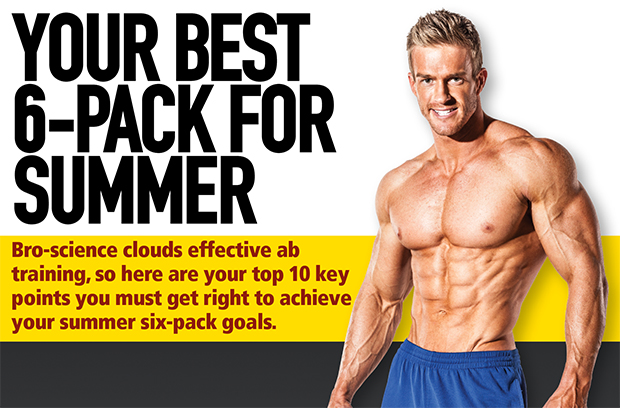
Bro-science clouds effective ab training, so here are your top 10 key points you must get right to achieve your summer six-pack goals.
Not long ago, my boss showed me a photo on Instagram of a top-five ranked professional bodybuilder doing a “novel” ab exercise using the forward portion of his foot to lift the padded lever on the leg extension (he was facing the unit) as high as possible. Tens of thousands of Likes later, I wondered how many other followers had started to include this movement, which is … well, a great exercise for your hip flexors, a group of upper thigh muscles!
The abs are clouded in bro-science to a much higher degree than other muscle groups. Perhaps that’s because their muscle-fibre makeup is unlike other muscle groups, they grow frustratingly slow, they work in planes of motion generally misunderstood, they’re commonly sub-optimally targeted, and they even require you to unlearn some important form guidelines you use with other body parts.
So let’s dive into some important training considerations when doing abs, and at the end, we’ll show you a well-devised ab program to get you started.
1. Get to Know Your “Abs”
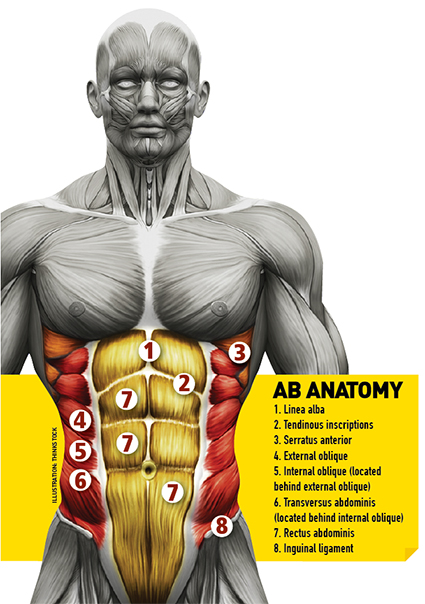 Don’t skip this section if you think learning the functions of the various muscles that make up the abs muscle groupand how they’re most effectivelyworked is a waste of time. It isn’t!
Don’t skip this section if you think learning the functions of the various muscles that make up the abs muscle groupand how they’re most effectivelyworked is a waste of time. It isn’t!
The rectus abdominisis the wide, thin sheath of muscle you most commonly think of when training the abs. Along with the transverse abdominisand the internal and external obliques, these muscles comprise your abs (the body part).The antagonist muscle of the rectus abdominis is the erector spinae (lower back); that is, when one is contracting (shortening), the other is stretching (lengthening). All together, these muscles make up your core.
The rectus abdominisextends from the sternum to the pelvis, segmented by three fibrous bands known as tendinous inscriptions, which segment the muscle into what appears to you as the six-pack. This particular muscle is responsible for forward flexion of the torso and raising the pelvis. It’s important to note that the abs get best worked when the physical distance between your sternum and pelvis is reduced;that is, the two ends of the muscle attached to these bones have to literally be pulled closer to each other. This distinction will come up time and time again when trying to separate real ab exercises from fakes!
The rectus abdominis is a single muscle, and while folks often think they’re doing an upper-ab or lower-ab exercise, it’s impossible to completelyisolate one portion of the muscle of the other. That being said:
When you stabilize your hips (your lower body remains stationary) by contracting the upper portion of the rectus abdominis, you draw your rib cage closer to your pelvis. In this instance, there’s a greater degree of muscle shortening in the upper-abdominal region(as in a crunch), which is why these kinds of movements are considered upper-ab moves.
When instead your torso is stationary, as in reverse-crunch movements and hanging leg raises, your pelvis is pulled back toward your rib cage, meaning the lower end of the rectus abdominis is undergoing a greater degree of shortening. This stresses the lower portion of the abdominals to a greater degree (but is again by no means isolation).
The obliquesare actually two muscles that run along both sides of your torso. The external oblique is the outermost of the two, and its fibres run diagonally from your lower ribs to the front area of your hip bone. The internal oblique is underneath, so it’s not visible superficially. The diagonal fibres run in the opposite direction to the fibres of the external obliques. The internals attach to the lower-back muscles on your backside and the lower ribs and hip bone in the front. These muscles assistin trunk flexion (as when doing crunch and reverse-crunch motions), but when working independently, they provide trunk rotation (think of a side-to-side twisting motion) and lateral flexion of the torso as when bending to one side.
The transverse abdominisis the deepest layer within your abs (essentially beneath the rectus abdominis and obliques) and is composed of thin fibres that extend horizontally across the front and sides. It helps keep the belly pulled in, one reason it should definitely be trained with abs. Because of that function, it’s called nature’s corset; a strong transverse abdominis can help you naturally suck in your gut. The TVA is involved in abdominal compression as when you forcefully exhale. The muscle helps keep your core tight whether doing basic ab exercises or big, heavy multi-joint lifts such as deadlifts and squats.
2. Fibre Types Matter
 It’s also worth reminding you the abdominals are a postural muscle, meaning they contract in coordination with other core muscles to keep you upright and stable. That kind of action requires an endurance component of your abdominals, so evolution has determined they be more slow twitch in nature. Those are the fibres more resistant to growth. With a lower percentage of fast-twitch fibres, that makes strengthening and building up the bricks of your six-pack more difficult than with other skeletal muscle groups (with the exception of the calves and forearms). Therein lies an important distinction as to how the abs are trained.
It’s also worth reminding you the abdominals are a postural muscle, meaning they contract in coordination with other core muscles to keep you upright and stable. That kind of action requires an endurance component of your abdominals, so evolution has determined they be more slow twitch in nature. Those are the fibres more resistant to growth. With a lower percentage of fast-twitch fibres, that makes strengthening and building up the bricks of your six-pack more difficult than with other skeletal muscle groups (with the exception of the calves and forearms). Therein lies an important distinction as to how the abs are trained.
3. Direct vs. Indirect Ab Training
 Lots of people may tell you they don’t do direct abdominal work and it’s a waste of time, and that may be true—for them! It’s certainly true when doing heavy deadlifts, bent-over rows, overhead presses, Romanians, or other standing or bent-over movements, your core muscles—especially the transverse abdominis—are being highly taxed, even on non-ab training days.
Lots of people may tell you they don’t do direct abdominal work and it’s a waste of time, and that may be true—for them! It’s certainly true when doing heavy deadlifts, bent-over rows, overhead presses, Romanians, or other standing or bent-over movements, your core muscles—especially the transverse abdominis—are being highly taxed, even on non-ab training days.
What’s worth noting here is your abs are for the most part contracting isometrically; that is, they’re not shortening or lengthening to any significant degree but rather just locking your core in a safe spinal position at a very specific angle. Isometric ab training like this builds strength but from that specific angle only; that’s a far cry from direct ab work in which you actively train the muscle over its entire range of motion. Hence, even if you’re doing lots of heavy lifting, you still need direct work for all the muscles of your core to complement that indirect work. Because the abs are a fairly small muscle group, they don’t require an extensive amount of direct training.
Note that in bent-over positions such as bent-over rows and lateral raises, the erectors are forced to work much harder to support this body position, but again this is still a more-or-less isometric position.
4. Make Your Ab Workouts Progressively More Challenging
 The worst approach you can take to your ab workout (besides skipping it) is to follow a generic 3-sets-of-20 scheme and think that’s just fine. An ab routine is just a list of exercises you do for a target number of sets and reps, but it still must be progressive in nature, as with other muscle groups. The key, as with any body part, is that as you get stronger as a result of training, you’ll make further improvements only if you continue challenging yourself by adding even more resistance, doing more reps, or reducing your between-sets rest intervals. That means you have to keep your brain focused on what you did each week and try to make your workouts more demanding in some manner—that is, if you want to continueimproving. Logging your training is probably the best way to remember what you did last time so that you can plan ways to increase the overload.This is called progressive overload, and it’s the foundation of how your body adapts and grows over time. If you’re always doing 3 sets of 20 with the same amount of resistance, you clearly won’t see any significant progress over time—ever!
The worst approach you can take to your ab workout (besides skipping it) is to follow a generic 3-sets-of-20 scheme and think that’s just fine. An ab routine is just a list of exercises you do for a target number of sets and reps, but it still must be progressive in nature, as with other muscle groups. The key, as with any body part, is that as you get stronger as a result of training, you’ll make further improvements only if you continue challenging yourself by adding even more resistance, doing more reps, or reducing your between-sets rest intervals. That means you have to keep your brain focused on what you did each week and try to make your workouts more demanding in some manner—that is, if you want to continueimproving. Logging your training is probably the best way to remember what you did last time so that you can plan ways to increase the overload.This is called progressive overload, and it’s the foundation of how your body adapts and grows over time. If you’re always doing 3 sets of 20 with the same amount of resistance, you clearly won’t see any significant progress over time—ever!
Make just incremental adjustments by slightly increasing the degree of challenge week over week; it’s in the long run where you’ll see more dramatic improvements.
5. Start Your Ab Workout with the Toughest Exercise
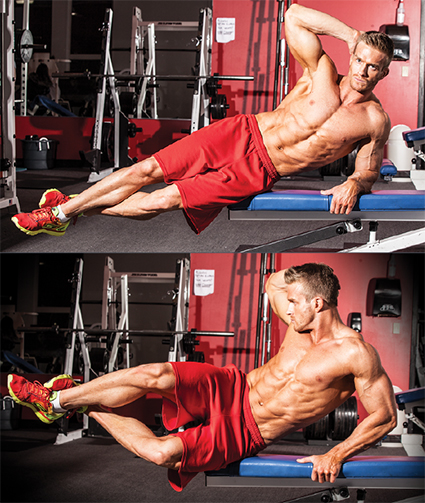 This seems like a no-brainer because you do that with every other muscle group, yet too many folks do high-rep stuff at the beginning of their workout for abs, which highly fatigues them for every exercise that follows. You’d never do squats last on leg day (except as an occasional shocker), so use the same approach with your abs, front-loading your workout with the hardest movements. If you use weighted exercises that allow you to work in somewhat lower rep ranges, you’ll want to do them first while your midsection is still fresh.
This seems like a no-brainer because you do that with every other muscle group, yet too many folks do high-rep stuff at the beginning of their workout for abs, which highly fatigues them for every exercise that follows. You’d never do squats last on leg day (except as an occasional shocker), so use the same approach with your abs, front-loading your workout with the hardest movements. If you use weighted exercises that allow you to work in somewhat lower rep ranges, you’ll want to do them first while your midsection is still fresh.
What’s more, not every body-weight exercise has the same degree of difficulty, either. Consider ways you can manipulate some body-weight movements, such as increasing angle of a decline bench or holding a plate against your chest or behind your head on floor crunches, or extending your legs on hanging knee raises.
6. Time to Time Your Rest Periods
 Let’s start with the recommendation you use your phone or watch to time your rest periods so you can be precise with them. For most body parts, it should be 60 to 90 seconds (on the longer side for larger muscle groups and multi-joint exercises). The reason this time interval has been established is that maintaining rest periods within that interval is an anabolic signaler for muscle growth; that is, you’ll get a more significant hormonal bump if you don’t violate those boundaries. It’s important to remember that accumulating muscle fatigue—meaning the fatigue carried over from one set to the next—is linked to hypertrophy through a mechanism called metabolic stress, one of three muscle-growth mechanisms. A longer rest period allows byproducts of anaerobic metabolism to clear, so you achieve a somewhat less favourable anabolic environment even though that may allow you to do more reps. And because you want to ensure fatigue builds up over the course of your ab workout, that’s why you begin the session with the most difficult exercise because it will be far more difficult to do later in your workout.
Let’s start with the recommendation you use your phone or watch to time your rest periods so you can be precise with them. For most body parts, it should be 60 to 90 seconds (on the longer side for larger muscle groups and multi-joint exercises). The reason this time interval has been established is that maintaining rest periods within that interval is an anabolic signaler for muscle growth; that is, you’ll get a more significant hormonal bump if you don’t violate those boundaries. It’s important to remember that accumulating muscle fatigue—meaning the fatigue carried over from one set to the next—is linked to hypertrophy through a mechanism called metabolic stress, one of three muscle-growth mechanisms. A longer rest period allows byproducts of anaerobic metabolism to clear, so you achieve a somewhat less favourable anabolic environment even though that may allow you to do more reps. And because you want to ensure fatigue builds up over the course of your ab workout, that’s why you begin the session with the most difficult exercise because it will be far more difficult to do later in your workout.
Less is known about the optimal rest period for your abs specifically, but because it’s a smaller muscle group comprised more dominantly of slow-twitch muscle fibres, start with a timed 30-second interval and adjust as necessary.Be consistent with your rest periods not only because you don’t want to be fully recovered when you start your next set but also because it’s important for keeping you on track to measure changes from one week to the next to ensure you’re actually achieving improvements in terms of progressive overload.You don’t want to be able to achieve a greater number of reps because you took an extended rest period as that may give you a false sense of making improvements when you’re really not.
7. Don’t Ever Maintain a Flat Back When Training Abs
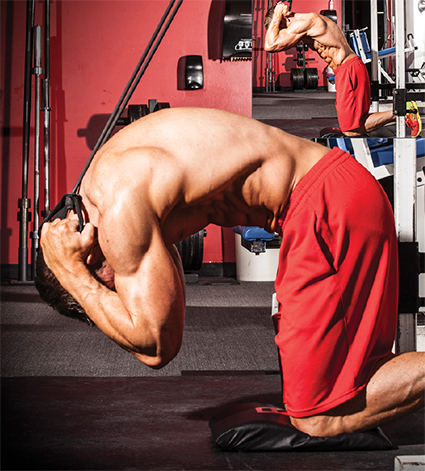 Keeping a flat or slightly arched back is absolutely critical on every bodybuilding exercise you do for spinal safety—except when it comes to core training. The problem is, it’s hard to unlearn that lesson when training abs, which you often see when folks do cable crunches or even decline crunches with a hip hinge.
Keeping a flat or slightly arched back is absolutely critical on every bodybuilding exercise you do for spinal safety—except when it comes to core training. The problem is, it’s hard to unlearn that lesson when training abs, which you often see when folks do cable crunches or even decline crunches with a hip hinge.
By lockingin a flat or slight arch in the lumbar/thoracic region of your spine, you ensure the antagonist muscle—the rectus abdominis—will notpossibly be able to activelycontract through a full range of motion. Remember, when the abs contract, the erectors stretch, so you can’t lock one side isometrically and expect the other to be able to be actively engaged. When you contract the rectus abdominis, you want to bring the pelvis and rib cage closer to each other, which stretches the low-back musculature (erectors). Holding an isometric contraction in the erectors isn’t compatible with trying to train your abs, which is why the motion mistakenly gets shifted to the nearby hip joint and is visible as a hip hinge. The motion in a hip hinge occurs at the joint; ab exercises take place above the joint, and you must see actual curling of the spine!
If you want to fully contract your abs, your back has to round.Curl your spine in a controlled manner on the concentric portion of the ab movement, thinking of the abs incrementally contracting (your spine is slowly flexing), as you draw your pelvis and rib cage closer to each other.
8. Take the Hip Flexors Out of the Equation
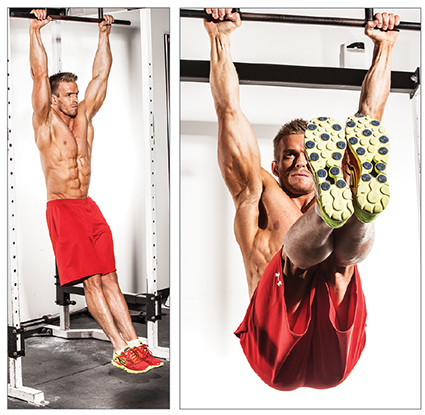 You’ve probably heard about the hip flexors and how they can take over an ab movement. The hip flexors are a group of upper-thigh musclesthat are below the hips, whereas the rectus abdominis is above the hips. You can work both muscle groups during an “ab” exercise, or just one or the other. Let’s see if we can clear up some confusion to reduce hip-flexor engagement to better focus on just the abs.
You’ve probably heard about the hip flexors and how they can take over an ab movement. The hip flexors are a group of upper-thigh musclesthat are below the hips, whereas the rectus abdominis is above the hips. You can work both muscle groups during an “ab” exercise, or just one or the other. Let’s see if we can clear up some confusion to reduce hip-flexor engagement to better focus on just the abs.
Hang from a pull-up bar, keeping your body straight. Now raise your legs up about 60 to 70 degrees. If you look to the side in a mirror, you’ll notice how your glutes haven’t budged much (an indication the pelvis hasn’t moved closer to the rib cage, which is essential in an abdominal movement). That’s an indication your lower abs aren’t yet even engaged; yep, it’s all hip flexors to this point. This makes sense as the hip flexors are by definition responsible for raising your legs (hip flexion). If you don’t bring your legs (or knees in hanging knee raises) any higher than this on your hanging movements, you’re not getting much bang for your buck. Now continue raising your legs well past that point—go as high as you can—and you’ll see how your glutes and lower back start to rotate. (Here, muscle shortening on the lower end of the rectus abdominis isbringing the pelvis closer to your rib cage.) And that’s the critical difference between recruiting the abs over the hip flexors!
What’s more, anchoring your lower legs or feet on some upper-ab exercises, as when doing decline-bench crunches or sit-ups on the floor with your feet anchored, makes it all too easy to “pull” through your upper thighs rather than using your abdominals to rise up. You’ll know it when your thighs are burning after a set of decline crunches, which has happened to me, a sure sign the hip flexors are doing the brunt of the work.
9. Don’t Set Artificial Limits on Rep Targets
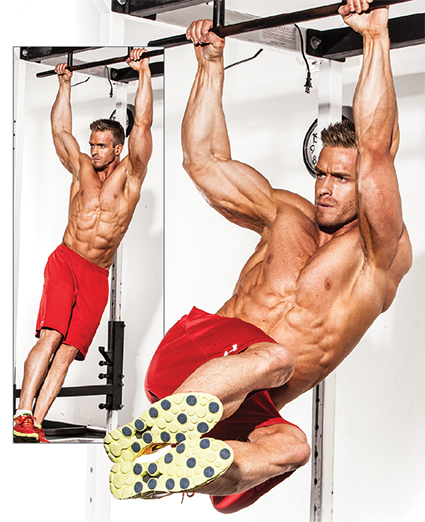 I detest seeing workouts that have precise rep targets for body-weight exercises. Why? Because it’s hard to adjust the load on body-weight movements, you should be doing as many as reps as possible until you reach muscle failure. If you stop at a predetermined rep, you’ll likely end a set before reaching muscle failure, won’t carry over fatigue from one set to another, and get less out of your training. With weighted movements, it’s far easier to manipulate the load to ensure you can find the right weight that causes failure at a particular rep target. That’s another reason to follow a stopwatch and log your results from previous workouts!
I detest seeing workouts that have precise rep targets for body-weight exercises. Why? Because it’s hard to adjust the load on body-weight movements, you should be doing as many as reps as possible until you reach muscle failure. If you stop at a predetermined rep, you’ll likely end a set before reaching muscle failure, won’t carry over fatigue from one set to another, and get less out of your training. With weighted movements, it’s far easier to manipulate the load to ensure you can find the right weight that causes failure at a particular rep target. That’s another reason to follow a stopwatch and log your results from previous workouts!
10. Follow These Specific Ab-Training Tips
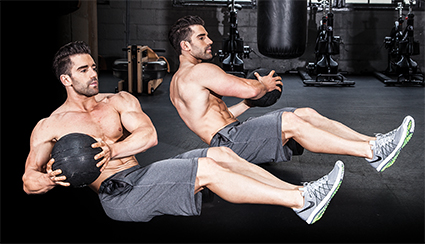 It would be easy to tell you to use good form on your ab exercises, but many trainers don’t even know what that means, so let’s go through a few important ones.
It would be easy to tell you to use good form on your ab exercises, but many trainers don’t even know what that means, so let’s go through a few important ones.
Use a moderately controlled rep speed—certainly notas fast as you can.With abs, the range of motion is fairly small and momentum can easily take over. Consciously contract the muscle and keep it under control. Holdthe peak-contracted position momentarily,which is impossible to do with momentum, squeezing the abdominals. If you rise up under control, you’ll also be able to benefit from the negative rep, so you’ll want to slow down the rep by lengthening the time of the eccentric motion, Ideally, in the bottom position your abs are still contracted, meaning you’re not able to rest between reps; that is, on floor crunches for example, don’t allow your shoulder blades to completely touch the floor between reps. That takes the stimulation off the muscle and affects time under tension.
The best advice when it comes to breathing for any body part: Hold your breath until you reach the top of the positive rep, then forcefully exhale. Holding your breath provides important spinal stability, which is critical not only when squatting but also with ab movements because it makes for a more forceful contraction, meaning you’ll be stronger. Exhaling too soon causes your intra-abdominal pressure to collapse, which means you have less stability and your performance will suffer. Inhale on the negative rep or at the bottom of the rep.
On some body-weight moves, you’ll be supporting your head in your hands, but don’t pull on your head!That can disrupt cervical spinal alignment and is a pretty useless effort because it has nothing to do with the abdominal contraction. Use your hands to support your head to keep neutral spinal alignment. Think of placing an imaginary tennis ball under your chin to better maintain cervical alignment.
Consistency is what’s going to get you to your goal. Don’t miss workouts, chart your progress, maintain a “good-pain” mentality, and make every workout better than the last one. That’s the way you’ll make long-term changes—one workout at a time.
I’d be remiss to neglect the importance of diet, especially, in your endeavors for a better six-pack. “You are what you eat” is never more true than with your abs. You’ll need to get your body-fat percentages into the single digits to visibly see those bricks, so reducing the body fat that blurs your definition should be aligned with a smart calorie-restricted diet.
Top-to-Bottom Ab Workout
Exercise Sets Reps1
Hanging Wipers2 3 to failure
Kneeling Cable Crunch 3 15
Hanging Leg Raise 3 to failure
Hanging Leg Raise (to side) 3 to failure
Lying Oblique Crunch 3 to failure
1Choose a load on weighted exercises to achieve muscle failure by the targeted rep. On body-weight exercises, go to muscle failure. If failure is below 10 reps, find a suitable variation of the movement that’s easier (such as doing a hanging knee raise instead of a hanging leg raise). If failure is above 20 reps, find a more difficult variation.
2This movement is extremely challenging and should most likely be done only by advanced trainers.
Get articles like this one delivered to your email each month by signing up for Muscle Insider’s mailing list. Just click here.

